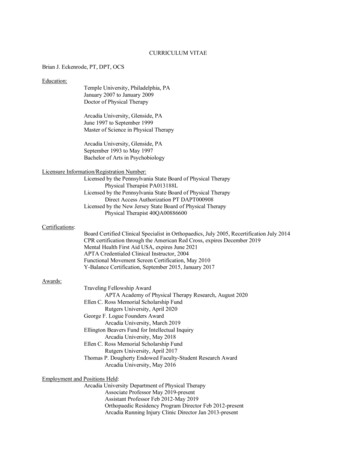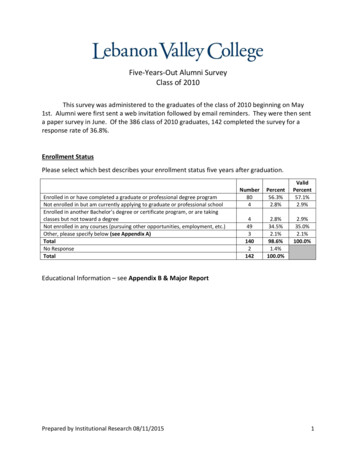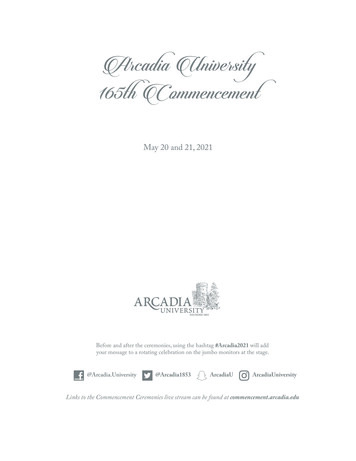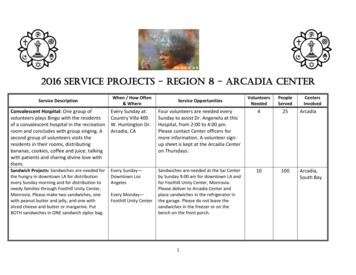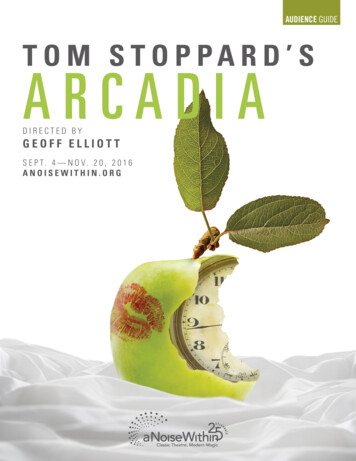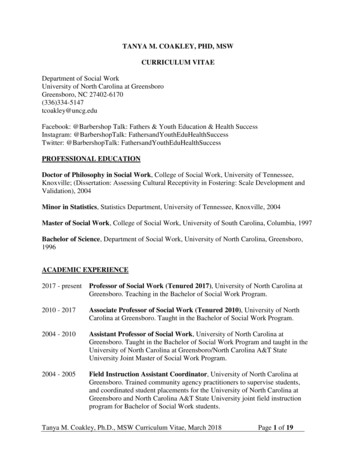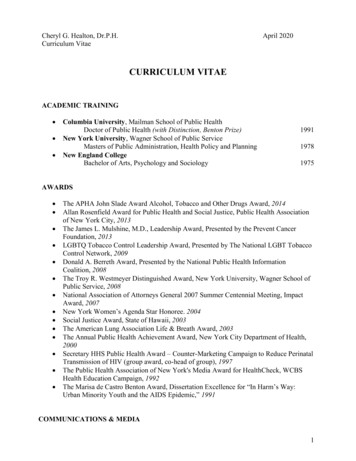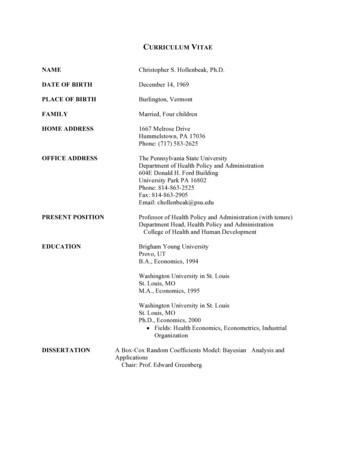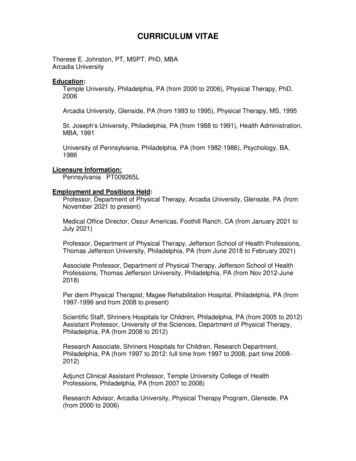
Transcription
CURRICULUM VITAETherese E. Johnston, PT, MSPT, PhD, MBAArcadia UniversityEducation:Temple University, Philadelphia, PA (from 2000 to 2006), Physical Therapy, PhD,2006Arcadia University, Glenside, PA (from 1993 to 1995), Physical Therapy, MS, 1995St. Joseph’s University, Philadelphia, PA (from 1988 to 1991), Health Administration,MBA, 1991University of Pennsylvania, Philadelphia, PA (from 1982-1986), Psychology, BA,1986Licensure Information:Pennsylvania PT009265LEmployment and Positions Held:Professor, Department of Physical Therapy, Arcadia University, Glenside, PA (fromNovember 2021 to present)Medical Office Director, Ossur Americas, Foothill Ranch, CA (from January 2021 toJuly 2021)Professor, Department of Physical Therapy, Jefferson School of Health Professions,Thomas Jefferson University, Philadelphia, PA (from June 2018 to February 2021)Associate Professor, Department of Physical Therapy, Jefferson School of HealthProfessions, Thomas Jefferson University, Philadelphia, PA (from Nov 2012-June2018)Per diem Physical Therapist, Magee Rehabilitation Hospital, Philadelphia, PA (from1997-1999 and from 2008 to present)Scientific Staff, Shriners Hospitals for Children, Philadelphia, PA (from 2005 to 2012)Assistant Professor, University of the Sciences, Department of Physical Therapy,Philadelphia, PA (from 2008 to 2012)Research Associate, Shriners Hospitals for Children, Research Department,Philadelphia, PA (from 1997 to 2012: full time from 1997 to 2008, part time 20082012)Adjunct Clinical Assistant Professor, Temple University College of HealthProfessions, Philadelphia, PA (from 2007 to 2008)Research Advisor, Arcadia University, Physical Therapy Program, Glenside, PA(from 2000 to 2006)
Adjunct Faculty, Temple University School of Allied Health, Physical TherapyDepartment, Philadelphia, PA (from 1999-2001)Staff Physical Therapist, Moss Rehabilitation, Philadelphia, PA. (part-time from 1997to 1998)Staff Physical Therapist, Magee Rehabilitation Hospital, Philadelphia, PA (from 1995to 1997)Project Director, Lynch Community Homes, Malvern, PA (from 1986 to 1993)Peer Reviewed Publications:Meyers B, Calhoun CL, Johnston TE. Spinal Cord Injury. In: Campbell SK, PalisanoRJ, Orlin MN (eds.). Physical Therapy for Children, 5th edition. St. Louis, MO:Elsevier, Inc., in press, 2022.Johnston TE. NMES and FES in Patients with Neurologic Diagnoses. In: Bellew JW,Michlovitz SL, Nolan TP. Michlovitz’s Modalities for Therapeutic Intervention,Seventh Edition. Philadelphia, PA: F. A. Davis Company, in press 2022.Craven BC, Burns AS, Carbone L, Cirnigliaro CM, Cowley K, Eng J, Forrest G, KiratliJ, Johnston TE, Morgan S, Morse L, Troy K, Weaver F. Bone Health andOsteoporosis Management in Individuals with Spinal Cord Injury: Clinical PracticeGuideline. Paralyzed Veterans of America, in press 2022.Sansare A, Behboodi A, Johnston TE, Bodt B, Lee SCK, Characterizing CyclingSmoothness and Rhythm in Children with and without Cerebral Palsy. Frontiers inRehabilitation Sciences. 2021;2:690046.Alizadeh M, Manmatharayan A, Johnston T, Finley M, Detloff M, Sharan A,Newburg A, Krisa L, Mohamed F. Graph Theoretical Structural Connectome Analysisof the Brain in Patients with Chronic Spinal Cord Injury: Preliminary Investigation.Spinal Cord Series and Cases, 2021;7(1):60-67.Johnston TE, Keller SA, Denzer-Weiler C, Brown LA. Clinical Practice Guideline forthe Use of Ankle Foot Orthoses and Functional Electrical Stimulation Post Stroke. JNeurol Phys Ther. 2021; Apr 1;45(2):112-196.Johnston TE, Jakavick AE, Mancuso CA, McGee KC, Wei L, Wright ML, Close J,Shimada A, Leiby B. Risk Factors for Stress Fractures in Female Runners: Resultsof a Survey. International Journal of Sports Physical Therapy, 2021;16(1):72-86.Johnston TE, Dempsey C, Gilman F, Tomlinson R, Jacketti A, Close J.Physiological Factors of Female Runners with and without Stress Fracture Histories.Sports Health, 2020;12(4): 334-340.Johnston TE, Close J, Jamora P, Wainwright SF. Perceptions of Risk for StressFractures: A Qualitative Study of Female Runners with and without Stress FractureHistories. Physical Therapy in Sport, 2020;43:143-150.Morse L, Biering-Søerensen F, Carbone L, Cervinka T, Cirnigliaro C, Johnston TE,Liu N, Troy K, Weaver F, Shuhart C, Craven B. Bone Mineral Density Testing inSpinal Cord Injury: the 2019 ISCD Official Positions. Journal of Clinical Densitometry,2019:22(4):544-556.
Johnston TE. Assessment of Medical Screening and Clinical Reasoning Skills byPhysical Therapy Students in a Simulated Patient Encounter. Internet Journal ofAllied Health Sciences and Practice. 2018 Apr 05;16(2), Article 10.Johnston TE, Baskins TA, Koppel RV, Oliver SA, Stieber DJ, Hoglund LT.Biomechanical Factors Related to Knee Pain in Cyclists: A Systematic Review of theLiterature. International Journal of Sports Physical Therapy. 2017:12(7):1023-1033.Streisfeld GM, Bartoszek C, Creran E, Inge B, McShane MD, Johnston T.Relationship Between Body Positioning, Muscle Activity, and Spinal Kinematics inCyclists with and without Low Back Pain: A Systematic Review. Sports Health.2017;9(1):75- 79.Johnston TE, Marino RJ, Oleson CV, Schmidt-Read M, Leiby BE, Sendecki J,Singh H, Modlesky CM. Musculoskeletal Effects of Two Functional ElectricalStimulation Cycling Paradigms Conducted at Different Cadences for People withSpinal Cord Injury: A Pilot Study. Archives of Physical Medicine and Rehabilitation.2016;97:1413-22.Calhoun CL, Krey CH, Johnston TE. Spinal Cord Injury. In: Campbell SK, PalisanoRJ, Orlin MN (eds.). Physical Therapy for Children, 4th edition. St. Louis, MO:Elsevier, Inc., 2016.Johnston TE. NMES and FES in Patients with Neurologic Diagnoses. In: Bellew JW,Michlovitz SL, Nolan TP. Michlovitz’s Modalities for Therapeutic Intervention, SixthEdition. Philadelphia, PA: F. A. Davis Company, 2016:399-434.Richardson RT, Nicholson KF, Rapp EA, Johnston TE, Richards JG. A comparisonof acromion marker cluster calibration methods for estimating scapular kinematicsduring upper extremity ergometry. Journal of Biomechanics. 2016 May 3;49(7):12558.Johnston TE, Krey CH. Pediatric Spinal Cord Injury. PTNow, hnston TE, Marino RJ, Oleson CV, Schmidt-Read M, Modlesky CM. Cycling withFunctional Electrical Stimulation Pre and Post a Distal Femur Fracture in a Man withParaplegia. Topics in Spinal Cord Injury Rehabilitation. 2015 Fall;21(4):275-281.Johnston TE, Forst N, Jones K, Backus DA. Cycling with Functional ElectricalStimulation after Spinal Cord Injury: What's in it for me? Archives of PhysicalMedicine and Rehabilitation. 2015;96(8):1553-1554.Johnston TE. Purposeful Error as a Diagnostic Tool to Assess StudentUnderstanding and Determine Teaching Needs in the Neuromuscular Curriculum.Journal of Physical Therapy Education. 2015;29(1):19-24.McDonald CM, Johnston TE. Metabolic Complications in Pediatric Spinal CordInjury: Combining Optimal Exercise and Nutrition to Promote Health and Fitness. In:Vogel LC, Zebracki K, Bezt RR, Mulcahey MJ. Spinal Cord Injury in the Child andYoung Adult. London, UK: Mac Keith Press, 2014:227-242.
Johnston TE, McDonald CM. Health and fitness in pediatric spinal cord injury:Medical issues and the role of exercise. J Pediatr Rehabil Med. 2013;6(1):35-44.Johnston TE. NMES and FES in Patients with Neurologic Diagnoses. In: MichlovitzSL, Bellew JW, Nolan TP. Modalities for Therapeutic Intervention, Fifth Edition.Philadelphia, PA: F. A. Davis Company, 2012:303-331.Gates PE, Banks D, Johnston TE, Campbell SR, Gaughan JP, Ross SA, EngsbergJR, Tucker CA. Randomized Controlled Trial Assessing Participation and Quality ofLife in a Supported Speed Treadmill Training Exercise Program vs. a StrengtheningProgram for Children with Cerebral Palsy. Journal of Pediatric RehabilitationMedicine. 2012;5(2):75-88.Krey CH, Johnston TE, Shakhazizisn KA, Massagli TL. Spinal Cord Injury. In:Campbell SK, Palisano RJ, Orlin MN (eds.). Physical Therapy for Children, 4thedition. St. Louis, MO: Elsevier, Inc., 2011:644-678.Johnston TE, Modlesky CM, Betz RR, Lauer RT. Muscle Changes following Cyclingand/or Electrical Stimulation in Pediatric Spinal Cord Injury. Archives of PhysicalMedicine and Rehabilitation. 2011;92:1937-43.Johnston TE, Watson KE, Ross SA, Gates PE, Gaughan JP, Lauer RT, TuckerCA, Engsberg JR. Effects of a supported speed treadmill training exercise programon impairment and function for children with cerebral palsy. Dev Med Child Neurol.2011;53(8):742-50.Lauer RT, Smith BT, Mulcahey MJ, Betz RR, Johnston TE. Effects of Cycling withand without Electrical Stimulation on Bone Mineral Density in Children with SpinalCord Injury. Spinal Cord. 2011;49(8):917-923.Johnston TE, Wainwright SF. Cycling with Functional Electrical Stimulation in anAdult with Spastic Diplegic Cerebral Palsy: A Case Report. Physical Therapy, 2011;91:970–982.Johnston TE, Smith BT, Mulcahey MJ, Betz RR, Lauer RT. A RandomizedControlled Trial on the Effects of Cycling with and without Electrical Stimulation onCardiorespiratory and Vascular Health in Children with Spinal Cord Injury. Archivesof Physical Medicine and Rehabilitation. 2009;90:1379-1388.Johnston TE, Betz RR, Lauer RT. The Impact of Cycling on Hip Subluxation inChildren with Spinal Cord Injury. Journal of Pediatric Orthopaedics. 2009;29(4):402405.McRae CGA, Johnston TE, Lauer RT, Tokay AM, Lee SCK, Hunt KJ. Cycling forChildren with Neuromuscular Impairments using Electrical Stimulation - Developmentof Tricycle-based Systems. Medical Engineering and Physics, 2009;31(6):650-659.Chafetz R, Johnston T, Calhoun C. Lower Limb Orthoses for Persons with SpinalCord Injury. In: Hsu JD, Michael JW, Fisk JR (eds). Atlas of Orthoses and AssistiveDevices, 4th edition. Philadelphia, PA: Elsevier, 2008.
Johnston TE, Lauer RT, Lee SCK. The Effects of a Shank Guide on CyclingBiomechanics of an Adolescent with Cerebral Palsy. Archives of Physical Medicineand Rehabilitation, 2008;89:2025-2030.Pierce SR, Johnston TE, Lauer RT, Shewokis PA. Examination of spasticity of theknee flexors and knee extensors using isokinetic dynamometry and clinical scales inchildren with spinal cord injury. Journal of Spinal Cord Medicine. 2008;31(2):208214.Johnston TE, Smith BT, Oladeji O, Betz RR, Lauer RT. Outcomes of a HomeCycling Program using Functional Electrical Stimulation or Passive Motion forChildren with Spinal Cord Injury: A Case Series. Journal of Spinal Cord Medicine.2008;31(2):215-221.Chou LW, Lee SCK, Johnston TE, Binder-Macleod SA. Effectiveness ofProgressively Increasing Stimulation Frequency and Intensity to Maintain ParalyzedMuscle Force during Repetitive Activation. Archives of Physical Medicine andRehabilitation. 2008;89:856-864.Johnston TE, Smith BT, Betz RR, Lauer RT. Exercise Testing using UpperExtremity Ergometry in Pediatric Spinal Cord Injury. Pediatric Physical Therapy.2008;20(2):146-151.Lauer RT, Johnston TE, Smith BT, Lee SCK. Lower extremity muscle activity duringcycling in adolescents with and without cerebral palsy. Clin Biomech (Bristol, Avon).2008;23:442-449.Johnston TE, Prosser LA, Lee SCK. Differences in Pedal Forces during RecumbentCycling in Adolescents with and without Cerebral Palsy. Clinical Biomechanics.2008;23:248-251.Johnston TE, Barr AE, Lee SCK. Biomechanics of Recumbent Cycling inAdolescents with Cerebral Palsy with and without the Use of a Fixed Shank Guide.Gait & Posture. 2008;27:539-546.Oladeji O, Johnston TE, Smith BT, Mulcahey MJ, Betz RR, Lauer RT. Quality of Lifein Children with Spinal Cord Injury. Pediatric Physical Therapy. 2007, 19(4), 296-300.Johnston TE. Biomechanical Considerations for Cycling Interventions inRehabilitation. Physical Therapy. 2007;87:1243-1252.Lauer RT, Johnston TE, Smith BT, Mulcahey MJ, Betz RR, Maurer AH. Bonemineral density of the hip and knee in children with spinal cord injury. Journal ofSpinal Cord Medicine, 2007;30: S10-S14.Ding J, Chou L, Kesar T, Lee SCK, Johnston TE, Wexler AS, Binder-Macleod SA. Amathematical model that predicts the force-intensity and force-frequencyrelationships of individuals with SCI. Muscle and Nerve, 2007;36:214-222.Johnston TE, Barr AE, Lee SCK. The Biomechanics of Submaximal RecumbentCycling in Adolescents with and without Cerebral Palsy. Physical Therapy.2007;87:572-585.
Scott WB, Lee SCK, Johnston TE, Binkley J, Binder-Macleod SA. Effect of ElectricalStimulation Pattern on the Force Response of Paralyzed Human QuadricepsMuscles. Muscle and Nerve, 2007;35:471-478.Davis R, Johnston T, Smith B, Betz R. Development of a Multi-functional 22Channel Functional Electrical Stimulator for Paraplegia (Chapter 33). In: Bronzino JD(ed). Biomedical Engineering Fundamentals. Boca Raton, FL: CRC Press, 2006.Johnston TE. Issues Surrounding Protection and Assent in Pediatric Research.Pediatric Physical Therapy. 2006;18:133-140.Scott WB, Lee SCK, Johnston TE, Binkley J, Binder-Macleod SA. ContractileProperties and the Force-Frequency Relationship of the Paralyzed HumanQuadriceps Muscle. Physical Therapy. 2006;86:788-799.Johnston, TE. Muscle Weakness and Loss of Motor Performance. In: Michlovitz S,Nolan TP. Modalities for Therapeutic Intervention 4th Ed. Philadelphia, PA: F. A.Davis Company, 2005: 247-270.Johnston TE, Betz RR, Smith BT, Benda BJ, Mulcahey MJ, Pontari MA, Davis R,Houdayer TP, Creasey GH, Barriskill A. Implantable FES System for Upright Mobilityand Bladder/Bowel Function for Individuals with Spinal Cord Injury. Spinal Cord.2005;43:713-723.Kebaetse MB, Lee SCK, Johnston TE, Binder-Macleod SA. Strategies that improveparalyzed human quadriceps femoris muscle performance during repetitive, nonisometric contractions. Archives of Physical Medicine and Rehabilitation.2005;86:2157-2164.Orlin MN, Pierce SR, Laughton Stackhouse C, Smith BT, Johnston TE, ShewokisPA, McCarthy JJ. The Immediate Effect of Percutaneous Intramuscular Stimulationduring Gait in Children with Cerebral Palsy: A Feasibility Study. DevelopmentalMedicine and Child Neurology. 2005;47:684-690.Johnston TE, Greco MN, Gaughan JP, Smith BT, Betz RR. Patterns of LowerExtremity Innervation in Pediatric Spinal Cord Injury. Spinal Cord. 2005;43:476-482.Johnston TE, Smith BT, Betz RR. Strengthening of Partially Denervated QuadricepsFemoris using Percutaneous Electrical Simulation in a Young Man with Spinal CordInjury. Archives of Physical Medicine and Rehabilitation. 2005;86(5):1037-42.Ding J, Lee SCK, Johnston TE, Wexler AS, Scott WB, Binder-Macleod SA. AMathematical Model That Predicts Isometric Muscle Forces for Individuals withSpinal Cord Injuries. Muscle & Nerve. 2005;31(6):702-712.Scott WB, Lee SCK, Johnston TE, Binder-Macleod SA. Switching StimulationPatterns Improves Performance of Paralyzed Human Quadriceps Muscle. Muscleand Nerve. 2005; 31(5):581-8.Chafetz RS, Johnston TE, Calhoun CL. Outcomes in Upright Mobility in Individualswith Spinal Cord Injury. Topics in Spinal Cord Injury Rehabilitation. 2005;10(4):94108.
Pierce SR, Orlin MN, Lauer RT, Johnston TE, Smith BT, McCarthy JJ. Comparisonof Percutaneous and Surface Functional Electrical Stimulation during Gait in a Childwith Hemiplegic Cerebral Palsy. American Journal of Physical Medicine &Rehabilitation. 2004;83(10):798-805.Johnston TE, Finson RL, McCarthy JJ, Smith BT, Betz RR, Mulcahey MJ. Use ofFunctional Electrical Stimulation to Augment Traditional Orthopaedic Surgery inChildren with Cerebral Palsy. Journal of Pediatric Orthopedics. 2004;24:283-291.Pierce SR, Laughton CA, Smith BT, Orlin MN, Johnston TE, McCarthy JJ. DirectEffect of Percutaneous Electrical Stimulation during Gait in Two Children withHemiplegic Cerebral Palsy. Archives of Physical Medicine and Rehabilitation.2004;85:339-343.Johnston TE, Moore SE, Quinn LT, Smith BT. Energy Cost of Walking in Childrenwith Cerebral Palsy: Relation to the Gross Motor Function Classification System.Developmental Medicine and Child Neurology. 2004;46:34-38.Johnston TE, Finson RL, Smith BT, Bonaroti DM, Betz RR, Mulcahey MJ. TheEffects of Percutaneous Functional Electrical Stimulation in Ambulatory Adolescentswith Incomplete Spinal Cord Injury. Journal of Spinal Cord Medicine. 2003;26:390400.Daichman J, Johnston TE, Evans K, Tecklin JS. The Effects Of A NMES HomeProgram on Quadriceps Strength, Hamstring Muscle Spasticity, Gait, and FunctionalMotor Skills of a Child with Spastic Diplegic Cerebral Palsy: A Case Report. PediatricPhysical Therapy. 2003;15:153-158.Johnston TE, Betz RR, Smith BT, Mulcahey MJ. Implanted Functional ElectricalStimulation: An Alternative for Standing and Walking in Pediatric Spinal Cord Injury.Spinal Cord. 2003;41(3):144-152.Betz RR, Johnston TE, Smith BT, Mulcahey MJ, McCarthy JJ. Case Report: Threeyear Follow-up of an Implanted Functional Electrical Stimulation System for UprightMobility in a Child with a Thoracic Level Spinal Cord Injury. Journal of Spinal CordMedicine. 2002;25(4):345-350.Spoltore T, Mulcahey MJ, Johnston T, Betz RR,Morales V, Rebuck C. Innovative Programs for Children and Adolescents with SpinalCord Injury. Orthopedic Nursing. 2000;19(3): 55-63.Published Abstracts of Peer Reviewed PresentationsJohnston TE, Chase C, Fratoni S, Heim E, Orkin S, Patel B, Salvo C. Risk Factorsfor Stress Fractures in Female Runners: A Systematic Literature Review. APTAPhysical Therapy Combined Sections Meeting, January 2019. J Ortho & Sports PhysTher. 2019; 49(1):175-6.Johnston TE, Dempsey C, Gilman F, Close J, Wainwright S. BiopsychosocialFactors of Female Runners with and without a History of Stress Fractures. PhysicalTherapy Combined Sections Meeting, January 2019. J Ortho & Sports Phys Ther.2019; 49(1):43.
Johnston TE, Baskins T, Koppel R, Oliver S, Stieber D, Hoglund LT. BiomechanicalFactors Related to Knee Pain in Cyclists: A Systematic Review of the Literature.JOSPT, 2018:48(1):A131-132.Johnston TE, Wainwright SF. Functional Electrical Stimulation Assisted Cycling inan Adult with Spastic Diplegic Cerebral Palsy. Ped Phys Ther, 2011:23(1):118.Johnston TE, Wainwright S. Cycling with Functional Electrical Stimulation: A CaseReport of an Ambulatory Adult with Cerebral Palsy. Arch Phys Med Rehabil,2010;91(10):e45.Watson KE, Johnston TE, Betz RR. A Home Based Treadmill Training Program fora Child with Cerebral Palsy: A Case Study. Ped Phys Ther, 2010:22(1):121.Johnston TE, Watson K, Engsberg J, Ross SA, Gates PL, Tucker CA, Betz RR.Gait Changes following a Supported Speed Treadmill Training Exercise Program(SSTTEP) for Marginally Ambulatory Children with Cerebral Palsy. Ped Phys Ther,2010:22(1):97.Johnston TE, Watson KE, Engsberg J, Ross SA, Gates PE, Tucker CA, Betz RR.Outcomes of a Treadmill Training Exercise Program for Marginally AmbulatoryChildren with Cerebral Palsy: A Preliminary Report. Arch Phys Med Rehabil,2009;90(10):e14.Johnston TE, Watson KE, Engsberg J, Ross SA, Gates PE, Tucker CA, Betz RR.Strength, Function and Gait Changes following a Supported Speed TreadmillTraining Exercise Program (SSTTEP) for Marginally Ambulatory Children withCerebral Palsy: A Preliminary Report. Dev Med Child Neurol, 2009;51(s5):63.Bulson M, Watson K, Johnston TE, Tucker CA. Speed Supported Treadmill TrainingExercise Program (SSTTEP) for a Child with Cerebral Palsy: A Case Study. PedPhys Ther, 2009:21(1):102-103.Johnston TE, Watson K, Engsberg J, Ross SA, Gates PL, Tucker CA. Strength andfunction changes following a speed supported treadmill training exercise program(SSTTEP) for marginally ambulatory children with cerebral palsy: A preliminaryreport. Ped Phys Ther, 2009:21(1):91-92.Johnston TE, Smith BT, Betz RR, Lauer RT. The Effects of FES Cycling forChildren with Spinal Cord Injury. Arch Phys Med Rehabil, 2008;89(10):e1-2.Johnston TE, Smith BT, Betz RR, Lauer RT. The Impact of Cycling and/or ElectricalStimulation on Hip Subluxation in Children with Spinal Cord Injury. Pediatric PhysicalTherapy, 2008;20:93.Johnston TE, Prosser LA, Lee SCK. Pedal Forces during Cycling in Adolescentswith and without Cerebral Palsy. Pediatric Physical Therapy, 2008;20:94.Johnston TE, Lauer RT, Smith BT, Betz RR. Outcomes of Cycling and/or ElectricalStimulation for Children with Spinal Cord Injury. Pediatric Physical Therapy,2007;19(1):80.
Lauer R, Johnston T, Oluwabunmi O, Smith B, Mulcahey MJ, Betz R.Musculoskeletal effects of cycling and or electrical stimulation in children with spinalcord injury. J Spinal Cord Medicine, 30(2), 171, 2007.Johnston TE, Lauer RT, Oladeji O, Smith BT, Mulcahey MJ, Betz RR.Cardiovascular and respiratory effects of cycling and/or electrical stimulation inchildren with spinal cord injury. Journal of Spinal Cord Medicine, 2007;30:S192.Johnston TE, Lee SCK, Smith BT, Lauer RT, Slater E. Muscle Activation Patternsduring Cycling in Adolescents with and without Cerebral Palsy. DevelopmentalMedicine and Child Neurology. 2006;106(48):43.Johnston TE, Lauer RT, Smith BT, Betz RR. Cardiovascular Effects of Cyclingand/or Electrical Stimulation in Pediatric Spinal Cord Injury. Developmental Medicineand Child Neurology. 2006;106(48):35.Pierce S, Johnston TE, Lauer RT. Examination of Spasticity of the Knee Flexorsand Knee Extensors using Isokinetic Dynamometry and Clinical Scales in Childrenwith Spinal Cord Injury. Journal of Neurologic Physical Therapy, 2005;29:192.Johnston TE, Lauer RT, Smith BT, Maurer AH, Betz RR. Bone Mineral Density inChildren with Spinal Cord Injury. Pediatric Physical Therapy. 2006;18(1):75-76.Johnston TE, Pierce SR, Laughton C, Smith BT. A Kinematic Analysis of PelvicMotion during Gait in Children and Adolescents with Incomplete Spinal Cord Injury.Journal of Spinal Cord Medicine, 2004;27:S113.Smith BT, Benda BJ, Johnston TE, Betz RR, Creasey G, Houdayer T, Barriskill A,Davis R. Improved Bladder/Bowel Management with the Praxis Functional ElectricalStimulation System. Journal of Spinal Cord Medicine, 2004;27:S116.Johnston TE, Smith BT, Betz RR, Mulcahey MJ, Benda BJ, Barriskill A, Davis R.Initial Experiences with the Praxis Functional Electrical Stimulation System forUpright Mobility. Journal of Spinal Cord Medicine, 2004;27:S119.Johnston TE, Urban IM. Gait Characteristics of Children and Adolescents withIncomplete Spinal Cord Injury. Topics in Spinal Cord Injury Rehabilitation,2000;6:215.Johnston TE, Mulcahey MJ, Betz RR, Smith BT. Totally Implanted FES for UprightMobility in an Adolescent with Paraplegia. Ped Phys Ther 10(4),1998.Professional Presentations:Johnston TE, Craven BC, Cowley K, et al. Moving from Recommendations toPractice: Spinal Cord Injury Bone Health Pearls for Therapists. Accepted for theParalyzed Veterans of American Summit, August 2022.Craven BC, Burns A, Morse L, Johnston TE, et al. Moving from Recommendationsto Practice: Bone Health Pearls for Physicians Treating Individuals with SCI.Accepted for the Paralyzed Veterans of American Summit, August 2022.
Johnston TE, Fox S, Hulcher T, Jackson J, Reynolds M, Vaccarella A, Wasser B.The Effect of Stance Width (Q-Factor) on Cycling Biomechanics & Knee Pain: ACase Series. APTA Physical Therapy Combined Sections Meeting, February 2021.Morse L, Craven C, Biering-Soerensen F, Johnston T. The Official Positions of theInternational Society for Clinical Densitometry: Indications for Bone Density Testingin Spinal Cord Injury. American Spinal Injury Association conference, September2020.Johnston TE, Clodfelter A, DiNenno M, Eisenberg L, Kreider K, Nwanonyiri I. RiskFactors for Stress Fractures in Female Dancers: Report of an Online Survey. APTAPhysical Therapy Combined Sections Meeting, February 2020.Johnston TE, Jakavick A, Mancuso C, McGee K, Wei L, Wright M, Shimada A,Leiby B. Risk Factors for Stress Fractures in Female Runners: Report of an OnlineSurvey. APTA Physical Therapy Combined Sections Meeting, February 2020.Johnston TE, Gorgey AS, Forrest GF. Mechanical and Electrical StimulationParadigms to Improve Body Composition, Fiber type, Bone, Health in Adults andChildren with Spinal Cord Injury. International Spinal Cord Injury Society, November2019.Morse L, Craven C, Biering-Soerensen F, Johnston T. The Official Positions of theInternational Society for Clinical Densitometry: Indications for Bone Density Testingin Spinal Cord Injury, International Spinal Cord Injury Society, November 2019.Gorgey AS, Johnston TE, Forrest GF. Testosterone Replacement Therapy with andwithout exercise after Spinal Cord Injury. American Spinal Injury Association, April2019.Johnston TE, Brown LE, Denzer-Weiler C, Keller SA. AFO and FES for Foot Drop inPost-Stroke Hemiplegia: Clinical Practice Guideline. APTA Combined SectionsMeeting, January 2019.Johnston TE, Gorgey AS, Forrest GF. Electrical Stimulation Paradigms to ImproveBone and Muscle Health. International Spinal Cord Injury Society, September 2018.Johnston TE, Chase C, Fratoni S, Heim E, Orkin S, Patel B, Salvo C. Risk Factorsfor Stress Fractures in Female Runners: A Systematic Literature Review. APTAPhysical Therapy Combined Sections Meeting, January 2019. J Ortho & Sports PhysTher. 2019; 49(1):175-6.Johnston TE, Dempsey C, Gilman F, Close J, Wainwright S. BiopsychosocialFactors of Female Runners with and without a History of Stress Fractures. PhysicalTherapy Combined Sections Meeting, January 2019. J Ortho & Sports Phys Ther.2019; 49(1):43.Johnston TE, Krisa L, Saksema S, Conklin C, Fisher J, Alizadeh M, Mohamed F.Central Nervous System Plasticity in a Man with Motor Incomplete TetraplegiaInternational Spinal Cord Injury Society, September 2018.
Johnston TE, Baskins T, Koppel R, Oliver S, Stieber D, Hoglund LT. BiomechanicalFactors Related to Knee Pain in Cyclists: A Systematic Review of the Literature.APTA Combined Sections Meeting, February 2018.Johnston TE, Krisa L, Saksema S, Conklin C, Alizadeh M, Fisher J, Mohamed F.Central Nervous System Connectivity in a Man with Motor Incomplete Tetraplegia.APTA Combined Sections Meeting, February 2018.Brown L, Johnston TE, Denzer-Weiler C, Keller S, Kaplan S. Clinical PracticeGuideline Appraisal Team Training Process and Outcomes. APTA CombinedSections Meeting, February 2018.Forrest GF. Gorgey AS, Johnston TE. Multiple Training Paradigms of FunctionalElectrical Stimulation after a Spinal Cord Injury. American Congress of RehabilitationMedicine, October 2017.Gorgey AS, Johnston TE, Forrest GF. Rehabilitation Paradigms in Restoring LeanMass and Bone Mass after Spinal Cord Injury. American Spinal Injury Association,April 2017.Gorgey AS, Johnston TE, Forrest GF Training Paradigms of Functional ElectricalStimulation and Exoskeleton in Persons with Spinal Cord Injury. American Congressof Rehabilitation Medicine, October 2016.Singh H, Johnston TE, Modlesky CM. Do Skeletal Effects of Functional ElectricalStimulation Cycling Paradigm at Low Cadence Differ in Cervical vs Thoracic SpinalCord Injury? American Spinal Injury Association, April 2016.Johnston TE, Wood S, Scheppers M, French J, Bryden A. Technology for UpperExtremity Restoration and Rehabilitation: The tools we have and what is needed.American Spinal Injury Association, April 2016.Tokay AH, Johnston TE, The Evolving Role of Mentorship: Exploring the Transitionfrom Mentee to Mentor. Physical Therapy Combined Sections Meeting, Feb 2016.Johnston TE, Shields RK, Forrest GF, Gorgey AS. Bone Health Post Spinal CordInjury: Current State of the Knowledge and Evidence for Change following PTInterventions. Physical Therapy Combined Sections Meeting, Feb 2016.Johnston TE, Carmack D, Fanto D, Llewellyn T, Parise E, Zabiegala K. The Effectsof Upper Body Aerobic Exercise on Peak Aerobic Output in People with Spinal CordInjury. American Congress of Rehabilitation Medicine, October 2015.Johnston TE, Wood S, Scheppers M, French J, Technology for Upper ExtremityRestoration and Rehabilitation: The tools we have and what is needed. AmericanCongress of Rehabilitation Medicine, October 2015.Johnston TE, Oleson CV, Modlesky CM. Cycling with Functional ElectricalStimulation Pre and Post a Distal Femur Fracture in a Man with Paraplegia.American Congress of Rehabilitation Medicine, October 2015.
Johnston TE. Use of Standardized Patients and Standardized Physicians during aPractical Examination Focused on Medical Screening. Interprofessional SimulationConference at Widener University, July, 2015.Levinson M, Hewston LA, Hunter L, Johnston TE, Pitts CV, Wainwright SF.Assessment of the DPT Professional Behavior Development Program at Graduationand 1-3 Years of Practice. Thomas Jefferson University Faculty Days, June 2015.Johnston TE, Schmidt-Read M, Marino RJ, Oleson CV, Leiby BE, Modlesky CM.Musculoskeletal Effects of Two Functional Electrical Stimulation Cycling Paradigmsfor People with Spinal Cord Injury. APTA Combined Sections Meeting, February2015.Johnston TE, Schmidt-Read M, Marino RJ, Oleson CV, Leiby BE, Modlesky CM.Musculoskeletal Effects of Two Functional Electrical Stimulation Cycling Paradigmsfor People with Spinal Cord Injury. American Congress of Rehabilitation Medicine,October 2014.Robertson E, Welk D, Dole RL, Hergenroeder A, Hoglund L, Johnston T, SchrieberJ, Wainwright SF, Hack LM. Educating Patients, Colleagues and Students in the 21stCentury. Pennsylvania Physical Therapy Association, October 2014.Gorgey AS, Forrest GF, Johnston TE. The Outcomes of Clinical Trials UtilizingElectrical Stimulation Training in Persons with Spinal Cord Injury. AmericanCongress of Rehabilitation Medicine, October 2014.Johnston TE, Schmidt-Read M, Marino RJ, Oleson CV, Leiby BE, Modlesky CM.Musculoskeletal Effects of Two Functional Electrical Stimulation Cycling Paradigmsfor People With Spinal Cord Injury. American Society for Bone and MineralResearch, September 2014.Johnston TE, Wolfram D, Herge EA. Simulation in a Culminating Physical TherapyClinical Decision Making Course. Thomas Jefferson University Faculty Days, June2014.Johnston TE, Craik RL, Field-Fote E, Hall C, Maxwell J, Zeni J. Why didn’t they likemy grant proposal or manuscript? How to interpret and respond to reviewers’comments. Physical Th
Research Advisor, Arcadia University, Physical Therapy Program, Glenside, PA (from 2000 to 2006) Adjunct Faculty, Temple University School of Allied Health, Physical Therapy Department, Philadelphia, PA (from 1999-2001) Staff Physical Therapist, Moss Rehabilitation, Philadelphia, PA. (part-time from 1997
